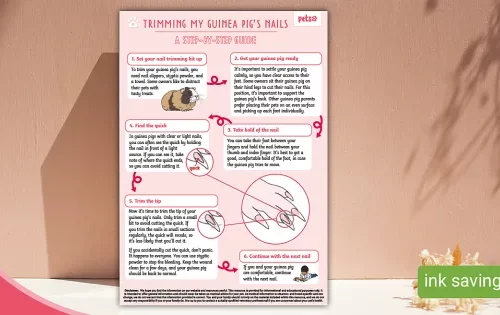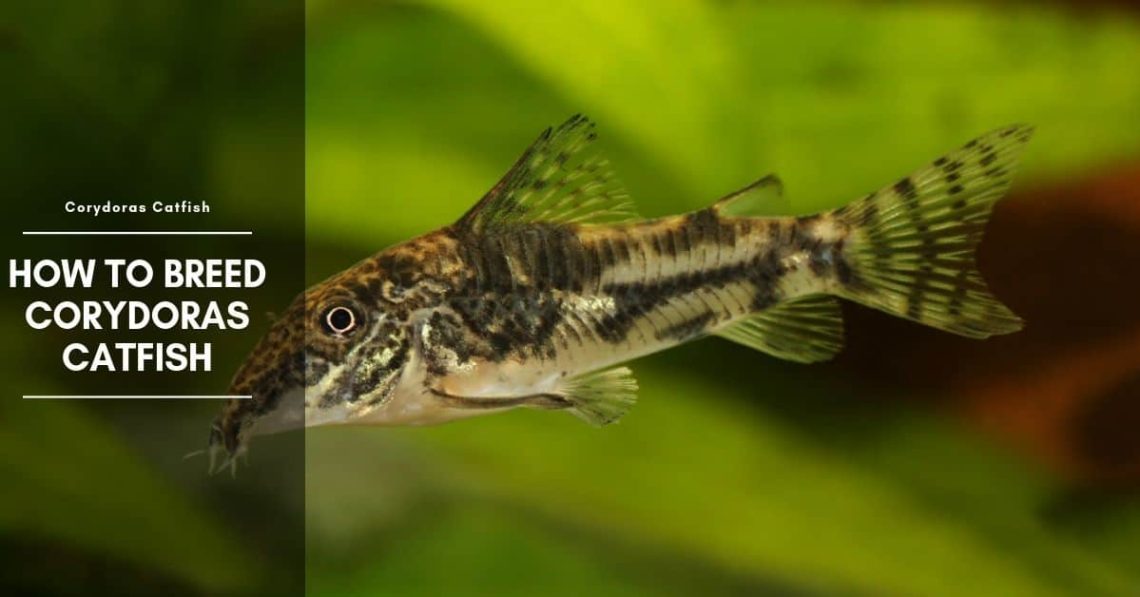
Corydoras: maintenance and care, breeding at home, reproduction and spawning and other features
Corydoras (Corydoras) are armored dwarf catfish. Due to the huge number of species and unusual, funny behavior, they have long earned great popularity and love among aquarists. These are small, very cute, active, peaceful and unpretentious aquarium fish. They lead a cheerful pack life, playing, hiding, chasing each other and actively tearing up the ground. Therefore, it is recommended to breed them in a group, which will be at least eight individuals. Next to their relatives, they feel much bolder and freer, showing all their characteristic features, amusing those who are watching them.
Contents
Description
Corydoras is characterized by a dense, short, rounded body, covered with bone plates in two rows. They replace the usual catfish scales. The fish has a convex back, high dorsal and two-lobed caudal fins. The oral cavity is located below, the lips are covered with three pairs of antennae, the eyes are rather large. Depending on the species, adults can grow from 3 to 15 centimeters.
A feature of the corridor is that it possesses both a gill and an intestinal respiratory system. Therefore, he not only lives at the bottom, but also regularly rises to the surface to capture some air.
There are many types of these fish. At the same time, in their homeland in the tropical and subtropical regions of North America, where they live in freshwater reservoirs, more and more new ones are found.
The most common types include the following:
Крапчатый (Corydoras paleatus). The body of the fish is gray-olive in color with dark spots and a pink belly with a touch of golden color. Among the individuals of this species are albinos. The length of the fish is 8 centimeters.
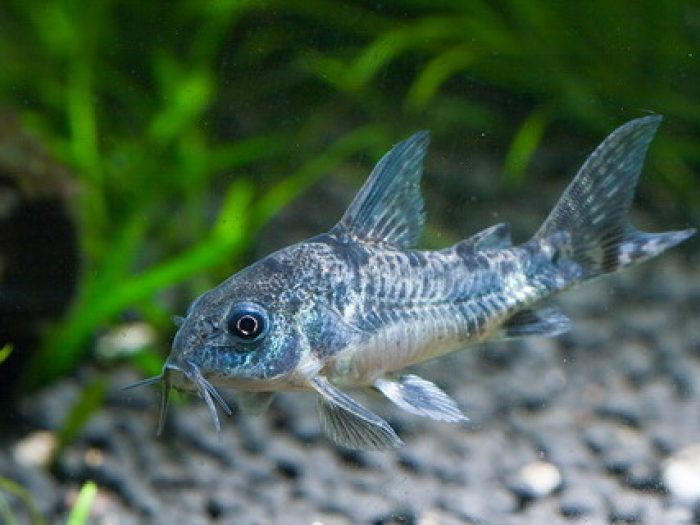
Speckled corridor – one of the oldest species
Golden (Corydoras aeneus). The body is uniformly painted in a golden-bronze color. Adults grow up to 7 centimeters.
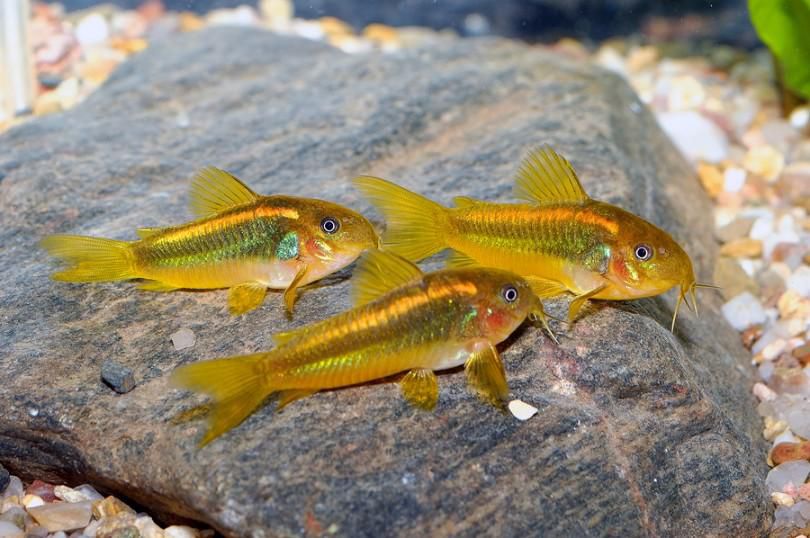
Golden Corydoras is a fairly small and interesting schooling fish that lives in the bottom area
Corydoras panda (Corydoras panda). It has a white color, diluted with black spots around the eyes, dorsal fin and base of the tail. These catfish grow no more than 4 centimeters.
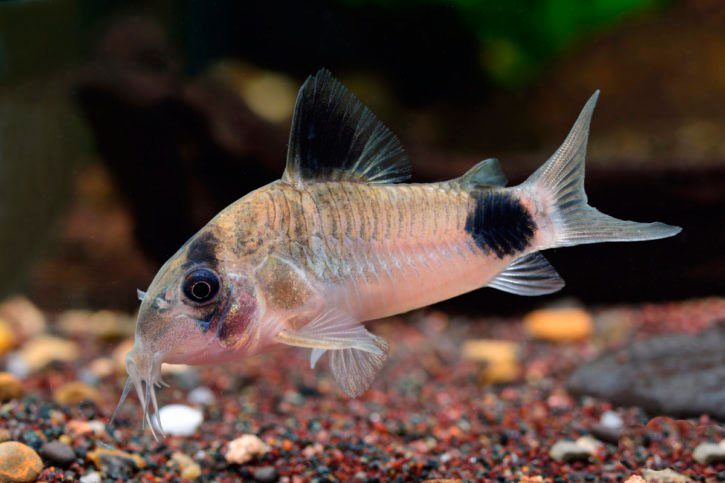
Panda corridor was opened in 1968
Штерба (Corydoras sterbai). It is characterized by the original black and white color. It has bright orange ventral fins, and rays of the same color are located on the pectoral fins. Fish reach 7 centimeters.
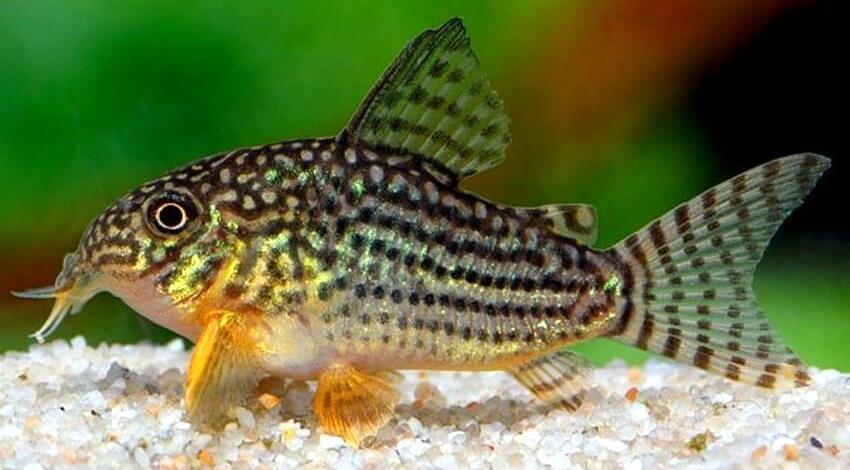
Sterba corridor is a very bright and popular catfish among aquarists.
Leopard (Corydoras trilineatus). The surface of the body is decorated with an original yellow-brown pattern. These catfish reach 6 centimeters in length.
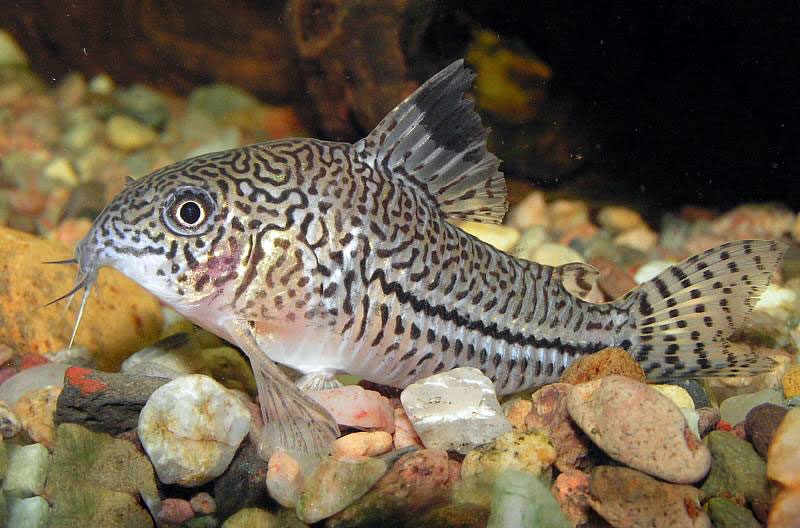
Another name for the leopard corridor is three-line
Arcuatus (Corydoras arcuatus). It has a light beige color, and a black stripe runs along its ridge. These fish grow up to 5 centimeters.
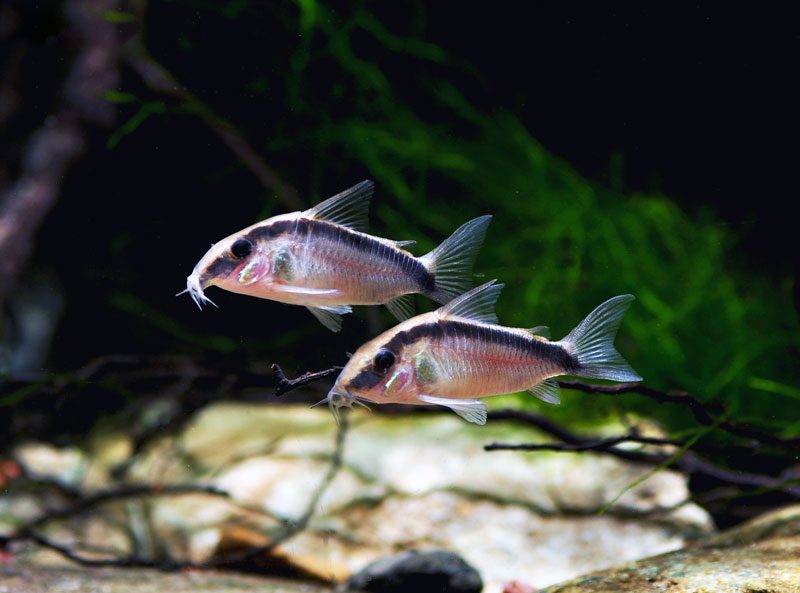
Corydoras Arcuatus is sometimes called a two-lane
Meta (Corydoras metae). It is a small fish with a beautiful yellow body color, a dark blue dorsal fin and transparent lateral fins. The length of an adult individual does not exceed 5 centimeters.

In the west, this fish is called bandit catfish.
Dwarf (Corydoras nanus). It is characterized by a beautiful pattern with light brown, yellow and silver tones over the entire surface of the calf. These fish can reach 7 centimeters in length.
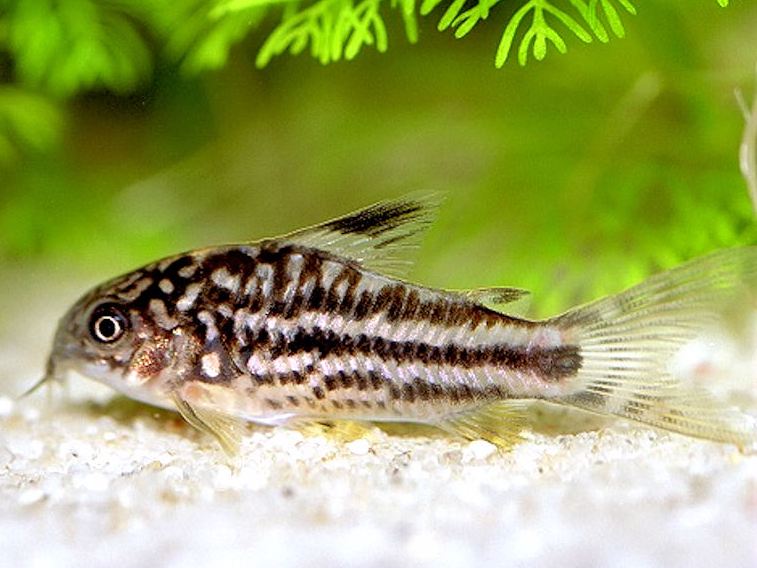
Corydoras nanus is a very mobile and nimble inhabitant of an aquarium with a strict coloration.
Pros and cons of corridors
The pluses in the content include the fact that these fish are unpretentious in care and nutrition. They can live in both weakly acidic and alkaline environments. And thanks to the variety of species, everyone can choose a catfish to their liking.
Among the shortcomings, it can be noted that, like all bottom fish, they spend most of their time below and very often dig in the ground, greatly stirring up the water in the aquarium. They also feed from the bottom, so it is recommended to cover it with pebbles or coarse sand in order to maintain the relative purity of the water. Also, some large species are quite difficult to breed at home.
Care and maintenance
To equip the bottom, it is better to choose dark pebbles or coarse sand, against which the original color of the fish will look much brighter and more spectacular.
Corydoras are completely unassuming little fish. Their maintenance will not be difficult even for those who are unfamiliar with the intricacies of aquarism.
What to feed
Feeding is not difficult. It is important to consider that, due to the structure of their oral cavity, they can only pick up food from the bottom. Therefore, you need to make sure that there is enough food for them.
To feed catfish, you can use dry food for bottom fish, as well as live or frozen brine shrimp, bloodworm, tubifex, daphnia, coretra. In order for the nutrition to be balanced, it is recommended to enrich their diet with special algae-based tablets.
Newly hatched fry are fed live dust six times a day. Starting from the second month, they are transferred to three meals a day. During this period, the diet includes ciliates, brine shrimp nauplii, rotifers, microworms, crushed egg yolks, chopped cucumbers. It is also recommended to add special tableted feeds to the diet, which include algae.
Diseases and treatment
With improper maintenance, catfish can suffer from various diseases, of which the most common are fungal and bacterial infections, helminthiasis and fin rot. Sometimes owners are faced with fish poisoning by toxic substances in the water.
Fungal diseases
This problem can be identified by specific growths, spots or cotton deposits on the body. In this case, you need to arrange baths for the fish in a separate container. To do this, you can use a weak solution of potassium permanganate, and hold the catfish in it for 5 minutes. If furatsilin is used, then it is taken from the calculation: 1 g per 10 liters of water. The duration of such a bath should be about half an hour. You can not use saline solutions, the fish do not tolerate salt and may die.
Bacterial infections
There are a lot of these diseases and their signs, for example, red spots, destruction of fins, apathy, loss of appetite. Only a specialist can diagnose and prescribe treatment. If you notice any abnormalities in the appearance and behavior of catfish, you should immediately consult a doctor.
Helminthiasis
With this disease, the fins can shrink in the fish, spots appear on the surface of the body. She may refuse to feed, rub against the ground, be lethargic or, conversely, have restless behavior. In this case, you need to visit an ichthyologist for examination and treatment.
Fin rot
The tips of the fins acquire a white-blue color. Gradually, such a border grows over the entire surface. Also, stripes or spots of red color may appear on the fins. Without proper treatment, white ulcers form and the fish die. To prevent this, it is necessary, upon detection of the first signs of the disease, to introduce chloramphenicol into the aquarium at the rate of 1 tablet per 20 liters of water. You can use bicillin-5 in accordance with the instructions.
Poisoning
If the corridor lies on its side and breathes frequently, poisoning with nitrates or nitrites in the water has occurred. In this case, it is necessary to immediately change the water in the aquarium, which must be of the appropriate quality.
Conditions of detention
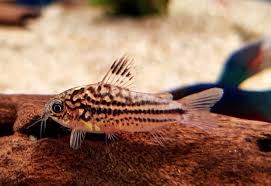
Corydoras spend most of their time scouring the bottom for food.
For a small flock of corridors, consisting of eight individuals, an 80-liter aquarium is enough. The optimal parameters for water can be considered as follows:
- temperature – 20–26 ° C;
- acidity – 6,5–7,5;
- hardness – 0–12°.
The soil must not be allowed to contain sharp particles. Since catfish are constantly rummaging in it, they can damage the antennae, which will cause great harm to their health. For a comfortable existence of the fish, a good filtration and aeration system should be organized.
In the aquarium, you need to place several large stones and snags, which will serve as shelters or a resting place. Strongly clutter up the bottom is not worth it, as it is the main habitat of these fish.
From plants it is worth giving preference to branchy, broad-leaved bushes or ferns, you can plant moss. All vegetation must be well fixed in the ground, as catfish can easily dig it out.
It is not recommended to decorate an aquarium containing corridors with a lot of floating greenery. The fact is that it is very important for them to have open access to the surface of the water.
Compatible with other inhabitants of the aquarium
Corydoras are well compatible with other peaceful catfish, such as Ancitruses. Favorable will be their settlement in the aquarium along with barbs, angelfish, bettas, danios, discus, platies, mollies, small shrimps.
Mastacembelus, astronotus, goldfish, koi carps are undesirable as neighbors. It is contraindicated to keep corridors and African or American cyclids, as well as other large and aggressive fish in the same aquarium. They will create discomfort, and can also cause damage to small catfish.
These fish are very active, but completely harmless creatures. And if they start chasing other fish, they just want to play. They cannot harm their neighbors.
Breeding corridors
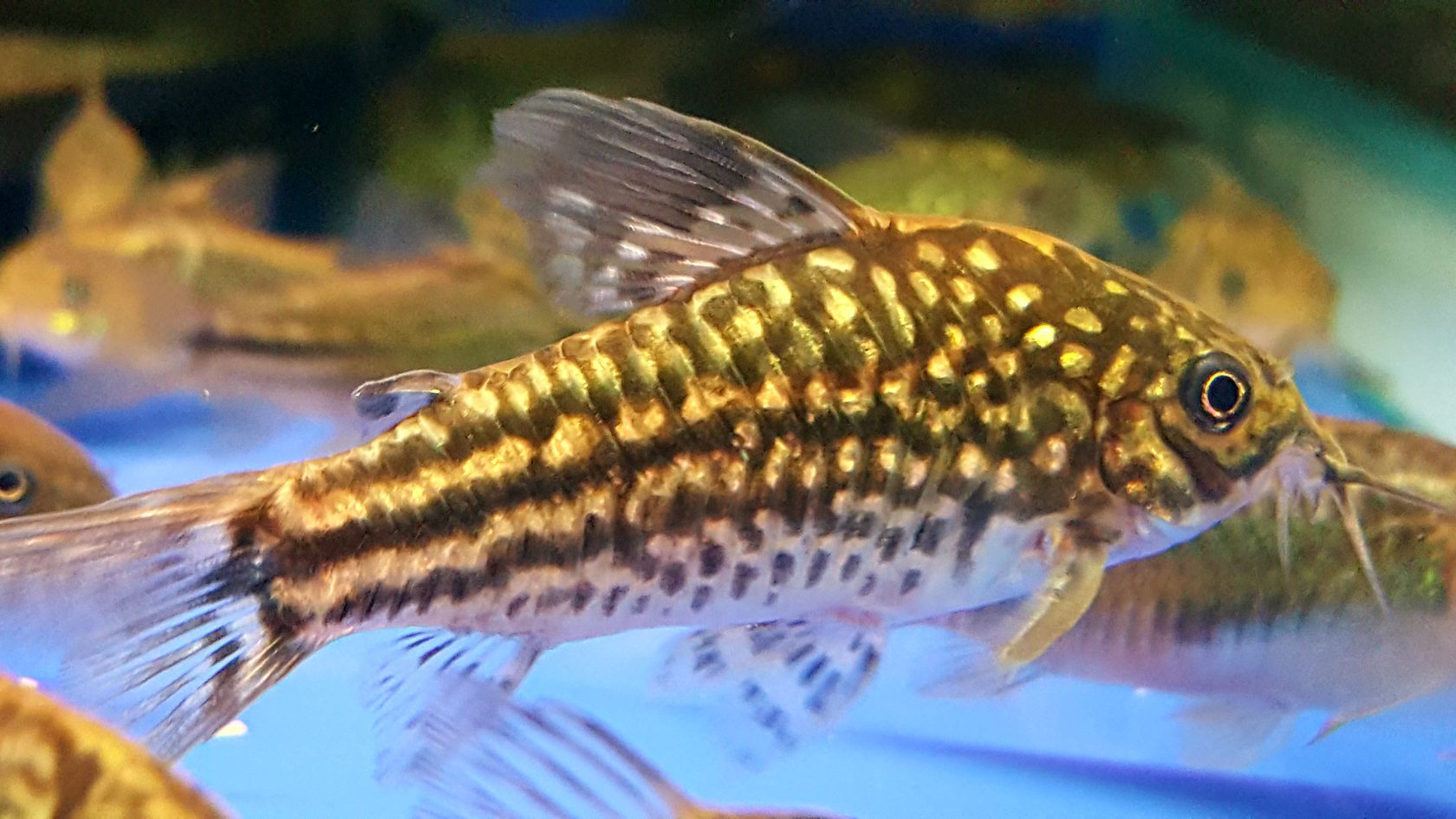
For breeding, the female of the corridor is planted with several males
Breeding most types of corridors at home, as a rule, is successful. It is only necessary to study the spawning process and the rules for breeding fry.
How to distinguish a female from a male
Corydoras have rather weakly expressed sexual characteristics, but it is still possible to determine their gender on their own. Females are usually larger, have a more rounded and wide body. Males have a more pointed dorsal fin, while females have a rounded one.
Mating and spawning
Mating and spawning is a rather entertaining process. These fish, depending on the species, reach sexual maturity at the age of 10 months to one and a half years, after which they are ready for breeding. But in order for the process to be successful, it is recommended to choose more mature individuals for this. Young catfish often give defective eggs, which die.
With targeted breeding, it is advisable to use a separate spawning tank, the volume of which should be 30 liters. The aquarium needs to be filled with water by 20 centimeters. Also, several large flat stones, large snags should be placed in it and plants with wide leaves should be planted. In this case, you need to choose an object and constantly illuminate it well. It will serve as a substrate for laying eggs.
One week before the planned spawning, females and males are separated from each other and begin to feed intensively using live food. At the same time, half of the water taken from the aquarium is replaced with a new one, and the temperature is reduced by several degrees. This will serve as a stimulus for reproduction. It is preferable to send producers to the spawning ground in the late afternoon, since at this time the catfish are most active. Usually two males are planted to one female. Spawning takes place in the following order:
- The males start chasing the female and then release their milt.
- The female collects them in her mouth, distributes them over the surface of the substrate or another place chosen by her for laying, for example, on the leaves of plants, and begins to stick eggs to it.
- The duration of laying can be delayed for a day. In such a situation, you need to pour food into the spawning ground. Otherwise, the fish may eat the laid eggs.
- After spawning is over, the producers are returned to the general aquarium. Catfish do not take care of the offspring, moreover, they can damage the eggs. The temperature of the water in the aquarium is increased by several degrees.
- The fertilized caviar has a pinkish color and a diameter of about 2 centimeters. In order for reproduction to be successful, it is recommended to treat it with methylene blue at the rate of 1 mg per liter of water. This will protect the eggs from fungal and bacterial infections.
- Under good conditions, the fry appear already 4–7 days after laying and feed on the contents of the gallbladder for several days. After 3 days they are already swimming and can eat live dust. They grow quite quickly and by the age of four months they are no different from adult fish. It is recommended to send them to a common aquarium no earlier than 2 months after hatching.
How many live at home
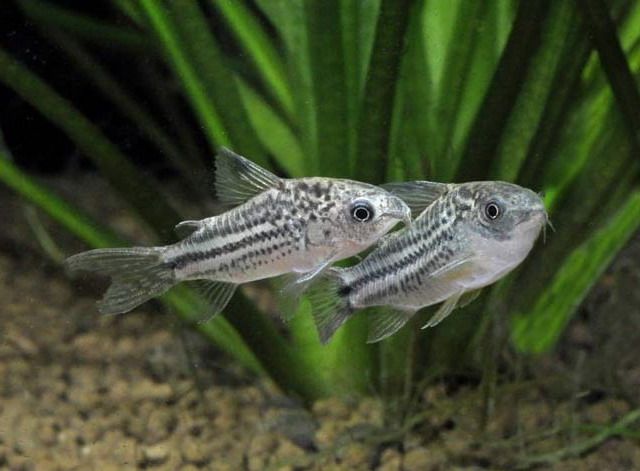
With proper care, corridors delight their owners for many years.
We can say that these fish are aquarium centenarians. With good care, properly created conditions for keeping and preventing diseases, their life expectancy can reach 15 years.
Corydoras are indeed quite unpretentious aquarium inhabitants. Their maintenance requires a minimum amount of time and physical costs. At the same time, the variety of their bright species allows you to decorate the aquarium with flocks of these good-natured catfish to your liking.




